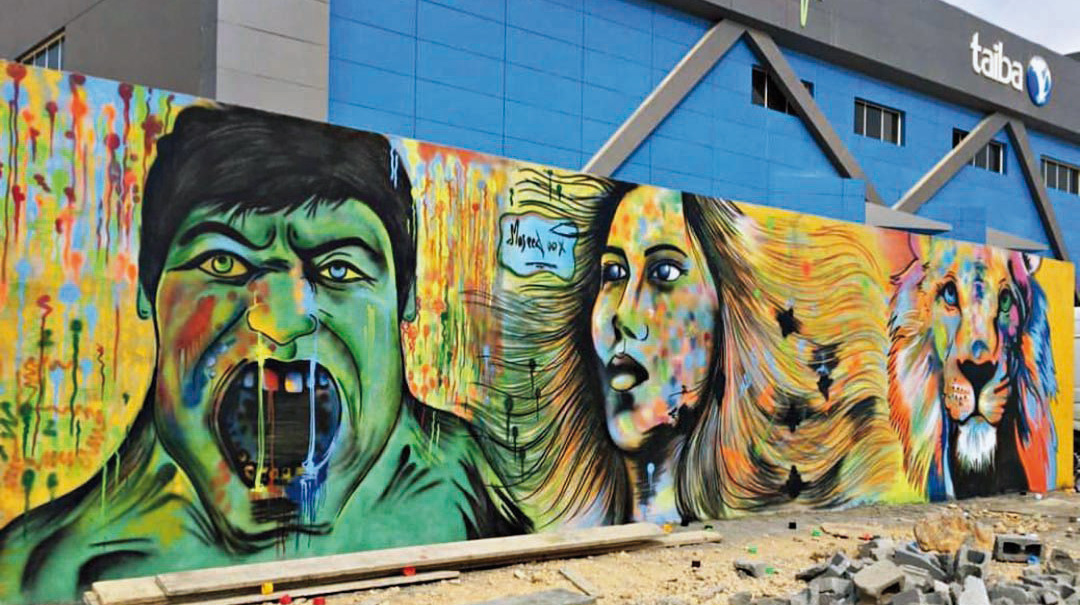

In various places around the world, streets are full of glamorous paintings on sidewalks and abandoned buildings. Because at times paper space is at a premium for artists to express their feelings and emotions. Feelings that need a wider space to translate on it and express ideas and convey them. This is called graffiti art. This art has spread over the Sultanate a few years ago. Nevertheless, those who are passionate about graffiti are increasing until the art has become used for advertising purposes, most notably its use on restaurant walls.
Abdul Majeed al Maamari is an Omani graffiti artist who transforms neglected walls into paintings to attract attention of passers-by.
“I got acquainted with this art by way of being a good listener for Hip-Hop music where it was closely related to the art of graffiti. Later, graphite became my interest and I chose to practice because it is the easiest way to express opinion in an previously unfamiliar way,” he says.
Like other artists, Abdul began his passion as a hobby and ended up making a living of it where he draws for payment. For example, to paint on a wall of a shop or restaurant.
But, unlike many artists, he has no role model or source of inspiration for producing his works. He usually paints as a reaction to the events that happen. Among his most prominent works is a mural of the Syrian child, Omran, who was found under the rubble on August 20, 2016.
Mural of the late Omani child, Maysoon al Rawahi, as she was loved by all as she was one who fought cancer and a strong strength for the rest of the patients.

For Abdul, practicing the art gives him psychological comfort and tranquility. He has his own ritual sharing, ‘I am only drawing while listening Hip-Hop music and I do not like excessive lighting, simple lighting is more comfortable”, he says.
“I like to do my work after midnight until dawn. I always make sure that the number of passers-by is very small so that I can focus,” he adds.
Societies around the world have a different perception towards painting on the walls or what is called graffiti art. While some see it as art, others consider it vandalism because of the damage it can happen or attached to the property of others. That is why opponents call it “the art of rioters or pettifogger,” as artists call it “street art”.
In Germany, for example, and not exclusively, graphic art is considered illegal and severely punished by law for the damage it causes to installations and buildings. Germany spends about 200 million euros annually to get rid of drawings, according to the ‘WD’ website in 2013.
London is the first international city to encourage such kind of visual arts with places dedicated to those who are passionate about it.
This graffiti artist from Harmoul in Wilayat of Liwa, was the first to appear in the Sultanate as a graffiti artist. He admits having faced several problems with the municipality in the beginning ‘because of their consideration of his work as a sabotage,’ he said.
He added that “some mural work was removed even though Harmoul witnessed active tourism and larger turnout by local citizens.
“The response I receive and the positive reinforcement and acceptance to my art boosts my confidence. Visitors always visit the area from Gulf countries and many celebrities from the Sultanate and outside who contact and praise my work, including footballer Ali al Habsi and Ahmed Kanoo,” he adds.
For the future, he is seeking to develop himself and to paint in larger areas. He hopes that the Sultanate’s interest in this art will be greater so that walls are allocated to support and he hopes the graffiti art is included in the curriculum like the other arts.
One of the most important steps that made graffiti art popular in the Sultanate is the painting on the wall of Sur, which is the longest mural in the ports in the world with a length of 1,300 metre and an area of 6,500 sq metre.
Its aim is to deliver a message that fishing ports are everyone’s responsibility to preserve them and give them importance in making them a beautiful haven for visitors.
Oman Observer is now on the WhatsApp channel. Click here



